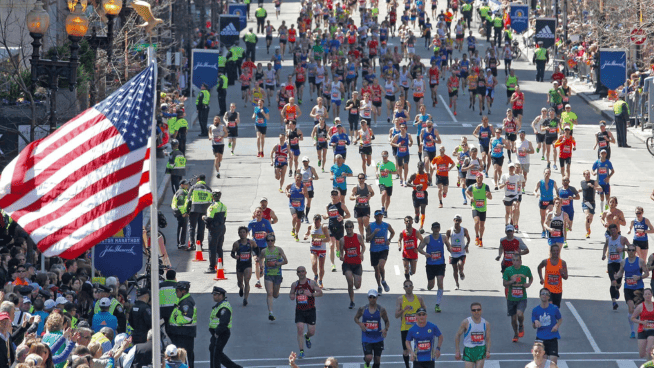Like other things in life, sports are constantly evolving. Football players no longer wear leather helmets, baseball players no longer smoke in the dugout, and basketball players no longer wear short shorts. Over the years, each major sport has seen immense changes in how their games are played; therefore, certain positions that were once important are on the verge of becoming obsolete. Read on to learn which five positions in sports hold less value than they used to.
NFL Fullback

Former Cleveland Browns fullback Lawrence Vickers (47) blocks for Josh Cribbs
Just 23 of 32 NFL teams even list the fullback position on their roster (not counting Mike Tolbert, who is listed on the Carolina Pathers depth chart as a fullback but is more of a running back). The description for the position is no longer just “run over defenders to make holes for the running back.” Pure fullbacks are drying up in a hurry as offenses in both college and the pros become more intricate and spread out.
Fullbacks are now asked to flank out of the backfield, stretch out to the flat to catch passes on play action or serve as the last read for the quarterback on dropbacks. If the fullback’s hands are made of stone, the team can insert a tight end to do the job for them.
Owen Marecic, a fullback out of Stanford who played both offense and defense, was drafted by the Cleveland Browns in the fourth round of the 2011 draft. His playing time was significantly reduced after he continually dropped passes when running routes out of the backfield. He wound up listed as inactive for six of the Browns’ final nine games in 2012 and was cut the following season. Consider the plummeting average salary for starting fullbacks ($1.1 million in 2013, less than kickers and punters). The position could be nothing more than a memory in the very near future.
NBA Spot-Up 3-Point Shooter

Jason Kapono launches a 3-pointer in 2010.
Remember James Kapono and Daniel “Boobie” Gibson? No? That’s probably because their limited skill set led to a short NBA shelf life. They both ascended to the ranks of professional basketball due to their above-average ability to shoot the 3-pointer, yet now they find their careers at a standstill.
Gibson had some moments of glory playing beside LeBron James in Cleveland, specifically his 31-point barrage in Game 6 of the 2007 Eastern Conference Finals. So did Kapono, who led the NBA in 3-point percentage during the 2006-2007 season, when he shot 51.4 percent from beyond the arc. Now Gibson finds himself out of the league. Kapono has been on seven different teams throughout his 10-year career.
The modern NBA is a cauldron of guys who can do more than just shoot the rock. This is why someone like J.J. Redick, who came into the league as a spot-up shooter, had to reinvent himself. Now he not only bombs from long range, but can move and run off picks to get easy buckets closer to the hoop. Redick is now a key cog in the Los Angeles Clippers offense. Sure, some guys still make a living shooting the long ball (Kyle Korver comes to mind), but they are much less common. It’s why Jimmer Fredette, a 3-point assassin in college, has struggled in the NBA. He can’t do much else.
Learn how to improve your 3-point shooting percentage.
NBA Center

Indiana Pacers center Roy Hibbert backs down Miami Heat forward LeBron James
The traditional center has been living on borrowed time for a while now, a dinosaur biding its time until inevitable extinction. The last of the giants is Indiana Pacers center Roy Hibbert, and his time as a dominant big man is dwindling.
In the 2014 NBA Playoffs, Hibbert played in several games without scoring a single point or grabbing a single rebound, which is unthinkable for a man standing 7-foot-2. NBA teams are trading centers for smaller, more athletic “tweeners.” The Miami Heat went to four straight NBA Finals with Chris Bosh at the 5.
New Orleans boasts Anthony Davis, a 6-foot-10 string bean who can run the floor, block shots and pop out to hit a jumper. The tallest players on the Cleveland Cavaliers are Tristan Thompson and Anderson Varejao, 6-foot-9 and 6-foot-10, respectively. Back to the basket behemoths are obsolete, as NBA teams look to roll out their most athletic starting five.
MLB Closer

Seattle Mariners closer Fernando Rodney
The last three outs of a nine-inning baseball game can sometimes be the hardest. It’s why a dominant closer one year can turn into a complete mess the next. The closer position is as much mental as it is physical. So, although it’s nice to employ a guy who can hold down the back of your bullpen for five-plus years, the truth is that’s just not realistic any more.
Take the Cleveland Indians as an example. For two years, the team’s closer, Chris Perez, was one of the best in baseball, registering 39 saves in 2011 and 36 in 2012. That number plummeted to 25 in 2013, and with Perez’s skills visibly withering, the team parted ways with the fiery closer at the end of the year. In his place, they signed John Axford, hoping the once-dominant Milwaukee Brewers closer could regain his form. When he couldn’t, he was jettisoned in favor of setup man Cody Allen, who thrived in his new role, notching 24 saves in a little over half a season.
MLB teams can no longer rely on one person as their closer for an entire year, much less multiple seasons.
NFL Blocking Tight End

Former Chicago Bears tight end Kellen Davis (87) blocks for running back Matt Forte (22).
The tight end position is in a state of metamorphosis, with players like Jimmy Graham, Rob Gronkowski and Travis Kelce lining up wide like a receiver almost as often as in tight like a traditional tight end. With the tight end turning into such a hybrid player, the need for a “blocking tight end,” a player whose function is strictly to help with O-line protection, has been greatly diminished. For one thing, when a team inserts a tight end who the defense knows will not run a pass route, the defense can expect a running play. Playing a blocking tight end also limits offensive plays and formations.
In Cleveland, tight end Jordan Cameron has nine receptions for 205 yards, despite missing multiple games due to injury. The Browns’ “blocking” tight end, Gary Barnidge has barely seen the field. If you can’t catch, the tight end position is no longer for you.
RECOMMENDED FOR YOU
MOST POPULAR
Like other things in life, sports are constantly evolving. Football players no longer wear leather helmets, baseball players no longer smoke in the dugout, and basketball players no longer wear short shorts. Over the years, each major sport has seen immense changes in how their games are played; therefore, certain positions that were once important are on the verge of becoming obsolete. Read on to learn which five positions in sports hold less value than they used to.
NFL Fullback

Former Cleveland Browns fullback Lawrence Vickers (47) blocks for Josh Cribbs
Just 23 of 32 NFL teams even list the fullback position on their roster (not counting Mike Tolbert, who is listed on the Carolina Pathers depth chart as a fullback but is more of a running back). The description for the position is no longer just “run over defenders to make holes for the running back.” Pure fullbacks are drying up in a hurry as offenses in both college and the pros become more intricate and spread out.
Fullbacks are now asked to flank out of the backfield, stretch out to the flat to catch passes on play action or serve as the last read for the quarterback on dropbacks. If the fullback’s hands are made of stone, the team can insert a tight end to do the job for them.
Owen Marecic, a fullback out of Stanford who played both offense and defense, was drafted by the Cleveland Browns in the fourth round of the 2011 draft. His playing time was significantly reduced after he continually dropped passes when running routes out of the backfield. He wound up listed as inactive for six of the Browns’ final nine games in 2012 and was cut the following season. Consider the plummeting average salary for starting fullbacks ($1.1 million in 2013, less than kickers and punters). The position could be nothing more than a memory in the very near future.
NBA Spot-Up 3-Point Shooter

Jason Kapono launches a 3-pointer in 2010.
Remember James Kapono and Daniel “Boobie” Gibson? No? That’s probably because their limited skill set led to a short NBA shelf life. They both ascended to the ranks of professional basketball due to their above-average ability to shoot the 3-pointer, yet now they find their careers at a standstill.
Gibson had some moments of glory playing beside LeBron James in Cleveland, specifically his 31-point barrage in Game 6 of the 2007 Eastern Conference Finals. So did Kapono, who led the NBA in 3-point percentage during the 2006-2007 season, when he shot 51.4 percent from beyond the arc. Now Gibson finds himself out of the league. Kapono has been on seven different teams throughout his 10-year career.
The modern NBA is a cauldron of guys who can do more than just shoot the rock. This is why someone like J.J. Redick, who came into the league as a spot-up shooter, had to reinvent himself. Now he not only bombs from long range, but can move and run off picks to get easy buckets closer to the hoop. Redick is now a key cog in the Los Angeles Clippers offense. Sure, some guys still make a living shooting the long ball (Kyle Korver comes to mind), but they are much less common. It’s why Jimmer Fredette, a 3-point assassin in college, has struggled in the NBA. He can’t do much else.
Learn how to improve your 3-point shooting percentage.
NBA Center

Indiana Pacers center Roy Hibbert backs down Miami Heat forward LeBron James
The traditional center has been living on borrowed time for a while now, a dinosaur biding its time until inevitable extinction. The last of the giants is Indiana Pacers center Roy Hibbert, and his time as a dominant big man is dwindling.
In the 2014 NBA Playoffs, Hibbert played in several games without scoring a single point or grabbing a single rebound, which is unthinkable for a man standing 7-foot-2. NBA teams are trading centers for smaller, more athletic “tweeners.” The Miami Heat went to four straight NBA Finals with Chris Bosh at the 5.
New Orleans boasts Anthony Davis, a 6-foot-10 string bean who can run the floor, block shots and pop out to hit a jumper. The tallest players on the Cleveland Cavaliers are Tristan Thompson and Anderson Varejao, 6-foot-9 and 6-foot-10, respectively. Back to the basket behemoths are obsolete, as NBA teams look to roll out their most athletic starting five.
MLB Closer

Seattle Mariners closer Fernando Rodney
The last three outs of a nine-inning baseball game can sometimes be the hardest. It’s why a dominant closer one year can turn into a complete mess the next. The closer position is as much mental as it is physical. So, although it’s nice to employ a guy who can hold down the back of your bullpen for five-plus years, the truth is that’s just not realistic any more.
Take the Cleveland Indians as an example. For two years, the team’s closer, Chris Perez, was one of the best in baseball, registering 39 saves in 2011 and 36 in 2012. That number plummeted to 25 in 2013, and with Perez’s skills visibly withering, the team parted ways with the fiery closer at the end of the year. In his place, they signed John Axford, hoping the once-dominant Milwaukee Brewers closer could regain his form. When he couldn’t, he was jettisoned in favor of setup man Cody Allen, who thrived in his new role, notching 24 saves in a little over half a season.
MLB teams can no longer rely on one person as their closer for an entire year, much less multiple seasons.
NFL Blocking Tight End

Former Chicago Bears tight end Kellen Davis (87) blocks for running back Matt Forte (22).
The tight end position is in a state of metamorphosis, with players like Jimmy Graham, Rob Gronkowski and Travis Kelce lining up wide like a receiver almost as often as in tight like a traditional tight end. With the tight end turning into such a hybrid player, the need for a “blocking tight end,” a player whose function is strictly to help with O-line protection, has been greatly diminished. For one thing, when a team inserts a tight end who the defense knows will not run a pass route, the defense can expect a running play. Playing a blocking tight end also limits offensive plays and formations.
In Cleveland, tight end Jordan Cameron has nine receptions for 205 yards, despite missing multiple games due to injury. The Browns’ “blocking” tight end, Gary Barnidge has barely seen the field. If you can’t catch, the tight end position is no longer for you.











